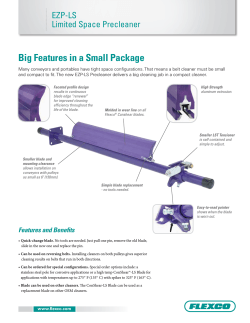
4 per mor
Algal Morphology I. Internal thallus morphologies II. External thallus morphologies III. Algal Growth Unicells- solitary cells can be motile or non motile ex. Chlamydomonas Colony- an assemblage of individual cells, variable or predictable d bl number b of f cells, ll flagellated fl ll d or non motile l coenobium- predictable number and arrangement of cells ex. Volvox Filamentous- daughter cells remain attached to each other following cell division forming a chain of cells Coenocytic/ Siphononous– one large multi-nucleate cell lacking crosswalls Uniseriate- cells occuring in a single row Utricles -swollen, terminal end of the siphon Multiseriate- consisting of several rows of cells in a longitudinal series in one or two planes Codium 1 Limited cell differentiation compared to terrestrial plants… Terrestrial Leaf Coenocytic thallus construction - Algal blade What does this allow? • Chloroplast movement What special issues does it raise? • Herbivory – healing • Well developed cytoskeleton • Repairs membrane in 1-2 seconds • cuticle • parenchyma (palisade, spongy) • veins • epidermal • guard cells Medulla • stomates Cortex-pigmented cortical cells – unpigmented medullary cells Pseudoparenchyma- form of thallus composed of interwoven continuous filaments, superficially resembles parenchyma Parenchyma – undifferentiated, isodiometric cells generated by a meristem Cells division in any plane , not filamentous Sarcodiotheca Filaments Hypnea 2 Parenchymatous vs. Pseudoparenchymatous Polysiphonous – composed of tiers of vertically elongated cells, transversely arranged, the lateral cells around a central axis (siphon) Reds only central cell surrounded by 4 or more pericentral cells Polysiphonia Petalonia Mazzaella Cortication – elaboration of polysiphonous condition where pericentral cells continue to proliferate Filament (Central Tissue) Ceramium nitens Cortical Cells (Outer Tissue) Complete Cortication Ceramium Cortical Cells (Banded Pattern) Partial Cortication 3 II. External thallus morphologies Algal morphology: sori Can affect: thallus blade - Photosynthesis - Nutrient uptake stipe - Resistance to herbivory holdfast - Resistance to physical disturbance (e.g. wave stress) Chaetomorpha Filamentous non-branching forms branching forms Filamentous Chaetomorpha Cladophora Derbesia 4 Prostrate / Procumbent: trailing on the ground Foliose = a sheet of cells, blade like, no stipe Monostromatic – one cell thick Distromatic - two cells thick Polystromatic – many cells thick Codium Petrospongium Crustose Grows flat along the substrate; crust-like. Ulva Hildenbrandia Bladed- flattened leaf like thallus, may have a stipe Ralfsia Stipitate = has a stipe 5 Saccate = sac-like Pneumatocysts-a large float containing gas found in heterokontophyta -provide buoyancy to lift the blades toward the surface, allowing them to receive more sunlight for Ps - can hold O2, CO2, CO Botryocladia Cystoseria osmundacea Halosaccion Midrib-thickened longitudinal axis of flattened branch or blade -catenate series Sargassum muticum -singly Midvein-a delicate median line of cells, the blade is thicker through this region Alaria fistulosa Undaria sp. 6 Tubular- tube of cells, hollow in center Geniculate corallines Geniculum (flexible joint) Intergeniculum (hard part between genicula) • upright •articulated •geniculate Non-geniculate corallines Calliarthron cheiliosporiodes Branched- axillary divisions • crustose • encrusting encrustin •non - geniculate 7 Dichotomous/Bifurcate Pectinate/Secund Whorled/Verticillate Pinnate-feather-like, regular opposite branching, distichous Distichous-branching on both side of the axis, irregular, opposite or alternate Monopodial-having a distinct main axis of continuous growth & giving off branchlets Sympodial- apparent main axis does not extend by continuous growth Opposite Alternate 8 Holdfast Types: III. Algal growth Discoid Disc-shaped holdfast apical Hapterous- network of small branches intercallary basal Stolon/Rhizome Creeping vegetative branch can also give rise to new plants Simple modified basal cell- one cell attached to the substrate Apical growth =Apical cell or apical meristem Where on the algal thallus does cell division occur? “Meristem” = area of cell division and growth Multiaxial- several longitudinal medullary filaments, each derived from an apical cell Pikea 9 Uniaxial- one longitudinal central filament forming the axis Apical around margin Intercalary Intercalary growth Diffuse growth = No defined area of cell division or growth; occurs throughout the thallus “transition zone” • Growth in both directions away from meristem • Usually between stipe and blade (or blade and pneumatocyst) 10 Trichothallic Growth: Cells divide to form hair (filament) above and thallus below Heterotrichous growth – filamentous growth in 2 directions, results in thallus composed of both prostrate + erect components (in this case, psuedoparenchymatous polysiphonous…) Polysiphonia Upright Form Filaments Thallus Prostrate Form (Crustose, spreading) Lithophyllum congestum Anticlinal Pattern of cell division perpendicular to surface of algae. Periclinal Cell division parallel to surface of plant. 11
© Copyright 2025















